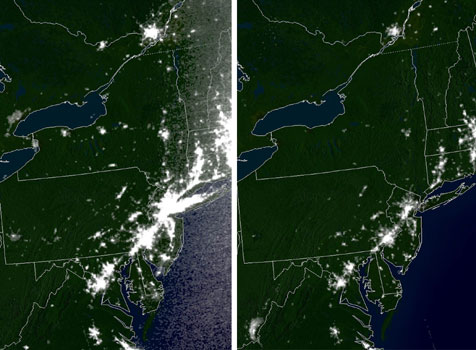Energy Security: Power to the People
Modern societies need energy to function. When supply is disrupted, life can come to a grinding halt. What are the threats and how are countries responding?
 |
BlackoutThe sun rises over the New York City skyline during a power outage in August 2003 (Photo: Reuters) |
Nine months after the great 1977 New York power blackout, birth rates in the city went up 35 percent. At least, that is the legend. What really happened during the blackout was less romantic: hundreds of shops were looted, buildings burnt to the ground, and damages amounted to over 300 million dollars.
No matter how you look at it, energy keeps modern societies afloat. Energy crises, however, are not a thing of the past. In August and September 2003, six major power blackouts in the U.S., Britain, Italy, Denmark, and Sweden left 112 million people in darkness, illustrating the fragility of overloaded supply networks.
Two years later, Hurricanes Katrina and Rita pounded the U.S. Gulf Coast, disrupting the supply of oil, natural gas, and electricity in the world’s first integrated energy shock.
Reasons I: Political Insecurity
Natural disasters, however, are not the only reason for supply problems. Producer nations are increasingly concentrated in volatile regions of the world, such as the Middle East and Equatorial Africa, because output of oil and natural gas from OECD nations will decline in the next decade. This volatility is reflected by unnaturally high oil prices; “risk premium” is what Allianz Energy Fund Manager Christopher Wheaton calls it.
Market concerns are not unfounded. Iraq produced around 3.5 million barrels of oil a day in the 1990s, but current production is down to less than 2 million barrels a day because of war and internal conflict. Kidnappings and sabotage in Nigeria regularly hamper oil production in Africa’s most important oil-exporting nation. Diplomatic tensions between Iran and the West could confound supply problems.
The case of Iran highlights another fragile piece of the energy supply puzzle. Most of the world’s fuel shipments pass through several “choke points,” including the Suez Canal, the Bosphorus, the Straits of Malacca, and the Straits of Hormuz next to the Iranian coast.
These points are vulnerable to accidents, blockades, piracy, or attacks. If Iran would be under attack it
Picture Gallery (click on the image to start)Massive blackouts happen all over the world. Find out why they happen and learn about their impact |
Reasons II: Lack of investments
These threats make headlines, but getting oil to markets is only half the deal. Well filled oil and gas tanks are useless, if national electricity infrastructure is not up to it.
“We have seen relatively little investment in power generation in the last decade,” says Ian Cronshaw, head of the energy diversification division at the International Energy Agency (IEA). “Governments need to invest in power generation and transmission.”
The UK National Grid has warned of a shortfall in electricity generating capacity for the winter of 2007-08, and the CEO of Italy’s largest utility, Enel, has said that blackouts are a distinct possibility because of a shortage of capacity.
Related Articles
Solutions I: Diversifying energy sources
Dependence on any one energy source has always been a burden. That is why some countries have begun to diversify their energy supply. The 1973 OPEC oil embargo spurred Europe into North Sea oil exploration and nuclear power. Today, nuclear plants generate about a third of Europe’s electricity.
Japan, which holds virtually no energy resources of its own, has reduced its reliance on Middle East oil by buying from Indonesia, Malaysia, and Australia, and by focusing on liquefied natural gas that can be transported by ship.
China has moved away from Middle Eastern sources to African producers like Sudan and Angola. Its state-owned oil company, Petrochina, controls huge oil fields and holds shares in African oil companies. China also explores ways to convert its considerable coal reserves into liquid oil. The United States, on the other hand, promotes “clean coal” technology that would “wash” coal and burn it hotter, thereby reducing carbon emissions.
Solutions II: Switching to renewable energy
Unlike in the 1970s, concerns about global warming are a factor, so simply switching from one fossil fuel to another is second best. Germany has promoted wind and solar power by enacting legislation that obliges utilities to buy renewable energy at a premium. Denmark uses its huge wind power potential to meet over 20 percent of its electricity demand.
“In Europe, governments are relying on economic incentives, carbon taxes, motor vehicle taxes, and money spent on public transport,” explains Malcolm Keay, senior research fellow at the Oxford Institute for Energy Studies. But efforts undertaken so far will only show lasting results if energy consumption can be held at a constant level or even reduced. There are two ways to do so: Improving energy efficiency and cutting demand.
“If governments don’t change their policies, oil and gas imports, coal use, and greenhouse-gas emissions are set to grow inexorably through to 2030,” says Nobuo Tanaka, executive director of the IEA. “These trends would threaten energy security and accelerate climate change.”
editor: James Tulloch
publishing date: November 23, 2007
© Allianz 2009, All Rights Reserved To subscribe or visit go to: http://knowledge.allianz.comwould probably try to stall any shipments from its neighbor countries through the Persian Gulf.

